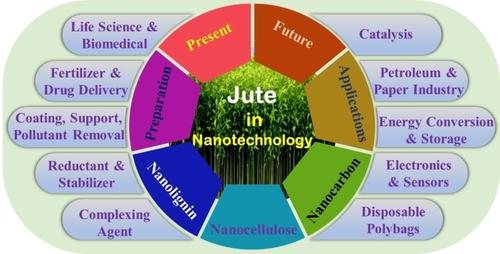当前位置:
X-MOL 学术
›
Chem. Rec.
›
论文详情
Our official English website, www.x-mol.net, welcomes your
feedback! (Note: you will need to create a separate account there.)
Present Status and Future Prospects of Jute in Nanotechnology: A Review
The Chemical Record ( IF 7.0 ) Pub Date : 2021-06-15 , DOI: 10.1002/tcr.202100135 Syed Shaheen Shah 1, 2 , M Nasiruzzaman Shaikh 1 , Mohd Yusuf Khan 1 , Md Almujaddade Alfasane 3 , Mohammad Mizanur Rahman 4 , Md Abdul Aziz 1
The Chemical Record ( IF 7.0 ) Pub Date : 2021-06-15 , DOI: 10.1002/tcr.202100135 Syed Shaheen Shah 1, 2 , M Nasiruzzaman Shaikh 1 , Mohd Yusuf Khan 1 , Md Almujaddade Alfasane 3 , Mohammad Mizanur Rahman 4 , Md Abdul Aziz 1
Affiliation

|
Nanotechnology has transformed the world with its diverse applications, ranging from industrial developments to impacting our daily lives. It has multiple applications throughout financial sectors and enables the development of facilitating scientific endeavors with extensive commercial potentials. Nanomaterials, especially the ones which have shown biomedical and other health-related properties, have added new dimensions to the field of nanotechnology. Recently, the use of bioresources in nanotechnology has gained significant attention from the scientific community due to its 100 % eco-friendly features, availability, and low costs. In this context, jute offers a considerable potential. Globally, its plant produces the second most common natural cellulose fibers and a large amount of jute sticks as a byproduct. The main chemical compositions of jute fibers and sticks, which have a trace amount of ash content, are cellulose, hemicellulose, and lignin. This makes jute as an ideal source of pure nanocellulose, nano-lignin, and nanocarbon preparation. It has also been used as a source in the evolution of nanomaterials used in various applications. In addition, hemicellulose and lignin, which are extractable from jute fibers and sticks, could be utilized as a reductant/stabilizer for preparing other nanomaterials. This review highlights the status and prospects of jute in nanotechnology. Different research areas in which jute can be applied, such as in nanocellulose preparation, as scaffolds for other nanomaterials, catalysis, carbon preparation, life sciences, coatings, polymers, energy storage, drug delivery, fertilizer delivery, electrochemistry, reductant, and stabilizer for synthesizing other nanomaterials, petroleum industry, paper industry, polymeric nanocomposites, sensors, coatings, and electronics, have been summarized in detail. We hope that these prospects will serve as a precursor of jute-based nanotechnology research in the future.
中文翻译:

黄麻在纳米技术中的现状与展望:综述
纳米技术以其多样化的应用改变了世界,从工业发展到影响我们的日常生活。它在整个金融部门有多种应用,能够促进具有广泛商业潜力的科学事业的发展。纳米材料,尤其是那些具有生物医学和其他健康相关特性的材料,为纳米技术领域增添了新的维度。最近,由于其 100% 环保功能、可用性和低成本,在纳米技术中使用生物资源已获得科学界的极大关注。在这种情况下,黄麻具有相当大的潜力。在全球范围内,其工厂生产第二大最常见的天然纤维素纤维和大量黄麻棒作为副产品。含有微量灰分的黄麻纤维和麻条的主要化学成分是纤维素、半纤维素和木质素。这使得黄麻成为纯纳米纤维素、纳米木质素和纳米碳制剂的理想来源。它也被用作各种应用中使用的纳米材料进化的来源。此外,可从黄麻纤维和麻条中提取的半纤维素和木质素可用作制备其他纳米材料的还原剂/稳定剂。本综述重点介绍了黄麻在纳米技术中的地位和前景。黄麻可应用的不同研究领域,例如在纳米纤维素制备、作为其他纳米材料的支架、催化、碳制备、生命科学、涂料、聚合物、能量储存、药物输送、肥料输送、电化学、用于合成其他纳米材料的还原剂和稳定剂,石油工业,造纸工业,聚合物纳米复合材料,传感器,涂料和电子产品,已详细总结。我们希望这些前景将成为未来基于黄麻的纳米技术研究的先驱。
更新日期:2021-07-12
中文翻译:

黄麻在纳米技术中的现状与展望:综述
纳米技术以其多样化的应用改变了世界,从工业发展到影响我们的日常生活。它在整个金融部门有多种应用,能够促进具有广泛商业潜力的科学事业的发展。纳米材料,尤其是那些具有生物医学和其他健康相关特性的材料,为纳米技术领域增添了新的维度。最近,由于其 100% 环保功能、可用性和低成本,在纳米技术中使用生物资源已获得科学界的极大关注。在这种情况下,黄麻具有相当大的潜力。在全球范围内,其工厂生产第二大最常见的天然纤维素纤维和大量黄麻棒作为副产品。含有微量灰分的黄麻纤维和麻条的主要化学成分是纤维素、半纤维素和木质素。这使得黄麻成为纯纳米纤维素、纳米木质素和纳米碳制剂的理想来源。它也被用作各种应用中使用的纳米材料进化的来源。此外,可从黄麻纤维和麻条中提取的半纤维素和木质素可用作制备其他纳米材料的还原剂/稳定剂。本综述重点介绍了黄麻在纳米技术中的地位和前景。黄麻可应用的不同研究领域,例如在纳米纤维素制备、作为其他纳米材料的支架、催化、碳制备、生命科学、涂料、聚合物、能量储存、药物输送、肥料输送、电化学、用于合成其他纳米材料的还原剂和稳定剂,石油工业,造纸工业,聚合物纳米复合材料,传感器,涂料和电子产品,已详细总结。我们希望这些前景将成为未来基于黄麻的纳米技术研究的先驱。











































 京公网安备 11010802027423号
京公网安备 11010802027423号